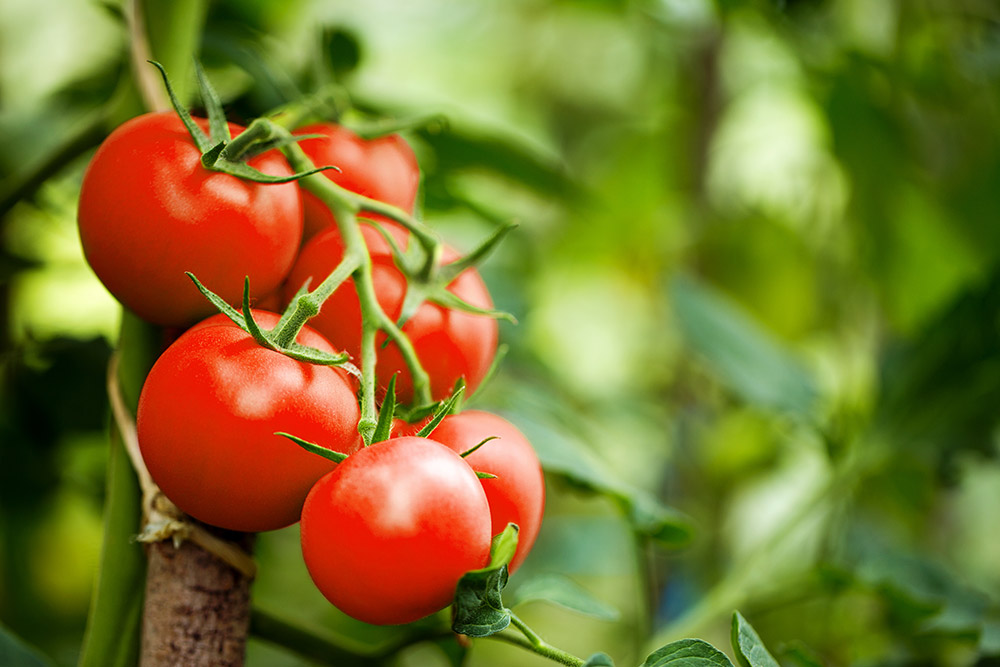
Growing edible plants and vegetables is something that practically everyone can do. You don’t need a huge yard (or any yard for that matter). Old cobbled lanes in ancient Italian cities are home to potted tomatoes and growing baskets of basil. Window boxes in San Francisco sprout green onions and refreshing mint. While high balconies in Seattle apartments are home to pots of strawberries, Romaine lettuce, and leeks.
If you do have a yard, then all the better. In short, you can grow edible plants in almost any location. Here is a guide to growing some of the best and easiest plants you can grow for food.
Tomatoes
Tomatoes come in many varieties, from cherry, to beefsteak, to Roma. Each have their various qualities and the heirloom varieties can be grown from seeds. Tomatoes are annuals, like full sun, prefer mulched soil, and can be grown in USDA Zones 2 through 10. Some varieties designated as “Bush Tomatoes” require little to no trellising or support. Harvest frequently to keep more tomatoes coming.
Blueberries
Blueberries are a perennial summer fruit that can be grown in USDA Zones 3-10. They like sun or partial shade and do well in acidic soil. Pine needles and oak leaves are a great source of acid for blueberries. If you have access to them, be sure to mix dried oak leaves into the soil when planting new blueberry bushes. Once planted, you can mulch blueberries with a thick layer of pine needles. Pine needle mulch will not only add acidity to the soil for your berry bushes, but it is excellent at preventing weeds.
Borage
Borage is an edible herb that likes direct sun, well drained soil, and can be grown anywhere in the U.S., the Caribbean, and South America. Borage is sometimes called Cuban Oregano, and has been grown and used for centuries. It is an annual that grows easily from cuttings, so it is fun to share baby plants with your neighbors and friends. Bees love the blooms and the somewhat succulent leaves can be used to flavor many dishes, as well as to make an invigorating tea. Soldiers in ancient times used to drink Borage tea before battle, giving rise to the phrase, “Borage for Courage.”
Kale
Kale has become extremely popular lately, due to its nutrient-rich composition and versatile nature. It is even rumored that Kale has become a popular baby name. But you don’t have to go as far as naming your first born after a leafy green to enjoy this delicious plant. Kale can be cultivated in all USDA Zones, is grown as an annual, likes shade, and does well in cool weather. It can be eaten raw or cooked, and the recipes for Kale available online are virtually endless.
Parsnips
Parsnips
resemble a white carrot, are easy to grow, and can be stored for an entire
winter. Parsnips are a root vegetable that can be grown in the ground or in
pots within USDA Zones 2 through 9. They like full sun, moist but not soggy
soil, and are usually harvested in late fall. Parsnips have a sweet, nutty
taste and can be eaten raw or cooked. They are great in stews, since their
sturdy texture holds up to long, slow cooking.
Peas
Peas are vines
that will climb a trellis or fence and do best in bright midday sun with some morning
or afternoon shade. Peas are an annual, can be grown in USDA Zones 2 to 11, and
prefer well drained but rich soil. Plant them in early spring and you can
expect to be harvesting your own pea pods in a month or two. There are many
varieties with field peas, sugar peas, and green peas being some of the most
popular.
Spinach
Growing spinach
is surprisingly easy, and you can harvest enough for a weekly spinach salad
from two 3-gallon pots on a patio or balcony. Spinach prefers sandy, well
drained soil, partial shade, and temperatures below 80ºF. It is best grown in
USDA Zones 3 to 9, and is considered an annual green edible vegetable. Water
frequently and harvest outside leaves as the plants grow. Spinach can be eaten
raw or cooked. Steamed spinach can also be frozen and used later.
Beets
Beets are a
biennial root vegetable suited to growing in USDA Zones 3 to 10. They like full
sun, well drained soil rich in organic matter, and consistent watering. They
can be grown in the ground but are also a great candidate for growing in pots.
Plant beets in early fall and watch their colorful stalks grow until they are
ready to harvest in about 45 days. If the first few you pick are smaller than
you would like, let the rest grow for another week or two, and you will be
thrilled to see how much bigger they get.
Peppers
Growing peppers is so fun that it can quickly go from a hobby to an obsession. You can grow peppers anywhere from the northern U.S. to South America and there are many varieties to choose from. Bell peppers are thick walled and sweet and used for salads, cooking, and pickling. Hot peppers such as jalapeno, scotch bonnet, and cayenne can add spice to dishes, be dried for making rubs, and added to soups or stews for extra kick. Grow peppers in pots or in the ground, and save the seeds from heirloom varieties to grow them again and again.

